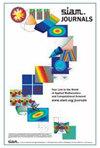Computationally Efficient Sampling Methods for Sparsity Promoting Hierarchical Bayesian Models
IF 1.9
3区 工程技术
Q2 MATHEMATICS, INTERDISCIPLINARY APPLICATIONS
引用次数: 0
Abstract
SIAM/ASA Journal on Uncertainty Quantification, Volume 12, Issue 2, Page 524-548, June 2024.Abstract.Bayesian hierarchical models have been demonstrated to provide efficient algorithms for finding sparse solutions to ill-posed inverse problems. The models comprise typically a conditionally Gaussian prior model for the unknown, augmented by a hyperprior model for the variances. A widely used choice for the hyperprior is a member of the family of generalized gamma distributions. Most of the work in the literature has concentrated on numerical approximation of the maximum a posteriori estimates, and less attention has been paid on sampling methods or other means for uncertainty quantification. Sampling from the hierarchical models is challenging mainly for two reasons: The hierarchical models are typically high dimensional, thus suffering from the curse of dimensionality, and the strong correlation between the unknown of interest and its variance can make sampling rather inefficient. This work addresses mainly the first one of these obstacles. By using a novel reparametrization, it is shown how the posterior distribution can be transformed into one dominated by a Gaussian white noise, allowing sampling by using the preconditioned Crank–Nicholson (pCN) scheme that has been shown to be efficient for sampling from distributions dominated by a Gaussian component. Furthermore, a novel idea for speeding up the pCN in a special case is developed, and the question of how strongly the hierarchical models are concentrated on sparse solutions is addressed in light of a computed example.
促进稀疏性的层次贝叶斯模型的计算高效采样方法
SIAM/ASA Journal on Uncertainty Quantification,第12卷,第2期,第524-548页,2024年6月。 摘要.贝叶斯层次模型已被证明能提供高效算法,用于寻找问题逆问题的稀疏解。这些模型通常由未知数的条件高斯先验模型和方差的超先验模型组成。超先验模型广泛使用的是广义伽马分布系列中的一个成员。文献中的大部分工作都集中在最大后验估计值的数值近似上,而较少关注不确定性量化的抽样方法或其他手段。从层次模型中取样具有挑战性,主要有两个原因:分层模型通常维度很高,因此会受到维度诅咒的影响,而且相关未知数与其方差之间的强相关性会使抽样效率相当低。这项研究主要解决了第一个障碍。通过使用一种新颖的重参数化方法,证明了如何将后验分布转化为由高斯白噪声主导的分布,从而可以使用预处理克兰-尼科尔森(pCN)方案进行采样,该方案已被证明可以高效地从由高斯成分主导的分布中进行采样。此外,我们还提出了一个在特殊情况下加快 pCN 速度的新想法,并根据一个计算实例探讨了分层模型在多大程度上集中于稀疏解的问题。
本文章由计算机程序翻译,如有差异,请以英文原文为准。
求助全文
约1分钟内获得全文
求助全文
来源期刊

Siam-Asa Journal on Uncertainty Quantification
Mathematics-Statistics and Probability
CiteScore
3.70
自引率
0.00%
发文量
51
期刊介绍:
SIAM/ASA Journal on Uncertainty Quantification (JUQ) publishes research articles presenting significant mathematical, statistical, algorithmic, and application advances in uncertainty quantification, defined as the interface of complex modeling of processes and data, especially characterizations of the uncertainties inherent in the use of such models. The journal also focuses on related fields such as sensitivity analysis, model validation, model calibration, data assimilation, and code verification. The journal also solicits papers describing new ideas that could lead to significant progress in methodology for uncertainty quantification as well as review articles on particular aspects. The journal is dedicated to nurturing synergistic interactions between the mathematical, statistical, computational, and applications communities involved in uncertainty quantification and related areas. JUQ is jointly offered by SIAM and the American Statistical Association.
 求助内容:
求助内容: 应助结果提醒方式:
应助结果提醒方式:


